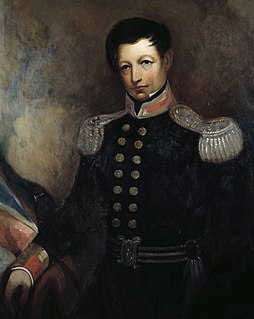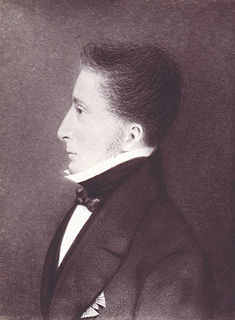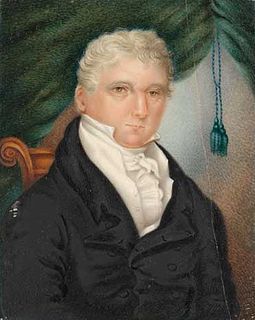John Thomas Collicott (23 September 1798 – 3 July 1840) was a farmer, auctioneer, postmaster of Hobart and one of the original investors in the Port Phillip Association.
The Port Phillip Association was formally formed in June 1835 to settle land in what would become Melbourne, which the association believed had been acquired by John Batman for the association from Wurundjeri elders after he had obtained their marks to a document, which came to be known as Batman's Treaty.
Collicott was born in England and emigrated to Sydney, Australia in 1819 on board the 'Mary Anne' . He was granted 200 acres (0.81 km2) of land by Governor Macquarie at Lake Illawarra which he named 'Campbell park'. [1]

England is a country that is part of the United Kingdom. It shares land borders with Wales to the west and Scotland to the north-northwest. The Irish Sea lies west of England and the Celtic Sea lies to the southwest. England is separated from continental Europe by the North Sea to the east and the English Channel to the south. The country covers five-eighths of the island of Great Britain, which lies in the North Atlantic, and includes over 100 smaller islands, such as the Isles of Scilly and the Isle of Wight.
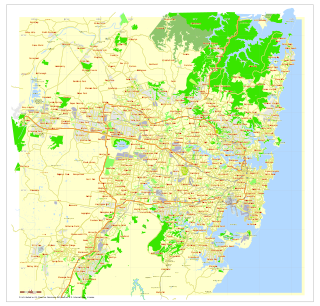
Sydney is the state capital of New South Wales and the most populous city in Australia and Oceania. Located on Australia's east coast, the metropolis surrounds Port Jackson and extends about 70 km (43.5 mi) on its periphery towards the Blue Mountains to the west, Hawkesbury to the north, the Royal National Park to the south and Macarthur to the south-west. Sydney is made up of 658 suburbs, 40 local government areas and 15 contiguous regions. Residents of the city are known as "Sydneysiders". As of June 2017, Sydney's estimated metropolitan population was 5,230,330 and is home to approximately 65% of the state's population.

Australia, officially the Commonwealth of Australia, is a sovereign country comprising the mainland of the Australian continent, the island of Tasmania and numerous smaller islands. It is the largest country in Oceania and the world's sixth-largest country by total area. The neighbouring countries are Papua New Guinea, Indonesia and East Timor to the north; the Solomon Islands and Vanuatu to the north-east; and New Zealand to the south-east. The population of 25 million is highly urbanised and heavily concentrated on the eastern seaboard. Australia's capital is Canberra, and its largest city is Sydney. The country's other major metropolitan areas are Melbourne, Brisbane, Perth and Adelaide.
Collicott leased his land and sailed for Hobart on 23 January 1819 and there entered business variously as a storekeeper, estate agent, auctioneer and speculator. In August 1823 Collicott was on the board that established the Bank of Van Diemen's Land, holding a considerable number of shares on his death. On the 17 August 1822 he was appointed postmaster at Hobart and conducted the post office from his rooms at Murray Street. At first he received no fixed salary but retained the postal fees he collected. Lieutenant-governor George Arthur later transferred the post office to government control granting Collicott 300 pounds per year. In 1834 he was appointed as a Commissioner of the Peace and in 1838 his salary was raised to 450 pounds. He was one of the original investors of the Port Phillip Association who were a group of businessmen who sent John Batman across to Port Phillip in 1835 to purchase a vast tract of land where Melbourne now stands. [1]

Hobart is the capital and most populous city of the Australian island state of Tasmania. With a population of approximately 225,000, it is the least populated Australian state capital city, and second smallest if territories are taken into account. Founded in 1804 as a British penal colony, Hobart, formerly known as Hobart Town or Hobarton, is Australia's second oldest capital city after Sydney, New South Wales. Prior to British settlement, the Hobart area had been occupied for possibly as long as 35,000 years, by the semi-nomadic Mouheneener tribe, a sub-group of the Nuennone, or South-East tribe. The descendants of these Aboriginal Tasmanians often refer to themselves as 'Palawa'.

The Bank of Van Diemen's Land was Tasmania's first commercial financial institution. Founded in 1823 prior to the use of the name Tasmania, it lasted for 68 years before becoming the first major bank failure of the 1890s depression in Australia. Although it had a reputation for reliability, during the 1880s the bank lent heavily to Tasmanians who invested heavily in silver mining ventures until mineral prices crashed in the 1890s leading to defaults on loan repayments that the bank was unable to survive. The bank closed its doors in August 1891, and offered up its banking premises as a £1 lottery ticket. Following the bank's demise, a Royal Commission was established to investigate allegations of fraudulent activities.
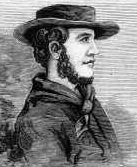
John Batman was an Australian grazier, entrepreneur and explorer. He settled in the north-east of the Van Diemen's Land Colony in the 1820s, and later as a leading member of the Port Phillip Association he led an expedition which explored the Port Phillip Bay area on the Australian mainland with a view to establishing a new settlement there. He is best known for his role in the founding of the settlement on the Yarra River which became the city of Melbourne, eventual capital of the new Colony of Victoria, and one of Australia's largest and most important cities.
In poor health for some time, Collicott died suddenly on leave in Sydney. In recognition of his eighteen years service as postmaster the lieutenant-governor headed his funeral procession. [1]
